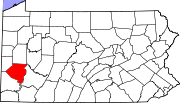Duquesne, Pennsylvania: Difference between revisions
Date links per wp:mosnum/Other |
|||
| Line 91: | Line 91: | ||
==External links== |
==External links== |
||
*[http://http://duquesnesdirtysecrets.blogspot.com/ Duquesne's Dirty Secrets] |
|||
*[http://www.cityofduquesne.com/ City of Duquesne website] |
*[http://www.cityofduquesne.com/ City of Duquesne website] |
||
*[http://digital.library.pitt.edu/maps/00vsein2.html G.M. Hopkins Map: South Eastern Vicinity of Pittsburgh, 1900] |
*[http://digital.library.pitt.edu/maps/00vsein2.html G.M. Hopkins Map: South Eastern Vicinity of Pittsburgh, 1900] |
||
Revision as of 15:32, 12 October 2008
Duquesne, Pennsylvania | |
|---|---|
 Location in Allegheny County, Pennsylvania | |
| Country | |
| Commonwealth | |
| County | Allegheny |
| Settled | 1885 |
| Incorporated | September 12, 1891 (borough) |
| January 7, 1918 (city) | |
| Area | |
| • Total | 5.3 km2 (2.0 sq mi) |
| • Land | 4.7 km2 (1.8 sq mi) |
| • Water | 0.6 km2 (0.2 sq mi) |
| Population (U.S. Census, 2000) | |
| • Total | 7,332 |
| • Density | 1,555.4/km2 (4,035.0/sq mi) |
| Time zone | UTC-5 (EST) |
| • Summer (DST) | UTC-4 (EDT) |
| Website | cityofduquesne.com |
Duquesne is a city along the Monongahela River in Allegheny County, Pennsylvania, United States and is part of the Pittsburgh Metropolitan Area. The population was 7,332 at the 2000 census.
History
The borough of Duquesne was settled in 1789. [1] Duquesne was incorporated in 1891. Population in 1900, 9,036; in 1910, 15,727; in 1914 (US estimate), 18,576; in 1920, 19,011; and in 1940, 20, 693.
Duquesne Works, a productive steel mill that was part of Carnegie Steel Corporation and later part of U.S. Steel, was the heart and soul of Duquesne during its brightest moments (40% of Duquesne's economy), but the municipality has deteriorated since 1950. Petty crimes perpetrated by small-time hoodlums were common for a while, circa 1970 to 2000, but a cooling-off became noticeable after 2000. According to the McKeesport Daily News, Duquesne has the worst performing schools in the state of Pennsylvania. Duquesne was designated a financially distressed municipality in 1991 by the state.
Duquesne High School closed in 2007. Beginning with the 2007-08 school year, Duquesne students have reported to West Mifflin High School, or East Allegheny High School. Since July of 2007, the Allegheny Intermediate Unit (AIU) has managed all academic and business operations of the Duquesne's K-8 school district.
Geography
Duquesne is located at 40°22′12″N 79°51′3″W / 40.37000°N 79.85083°WInvalid arguments have been passed to the {{#coordinates:}} function (40.369969, -79.850957)Template:GR. Duquesne is nestled along the Monongahela River approximately 12 miles (19 km) south of Pittsburgh.
According to the United States Census Bureau, the city has a total area of 2.0 square miles (5.3 km²), of which, 1.8 square miles (4.7 km²) of it is land and 0.2 square miles (0.6 km²) of it (10.84%) is water.
Demographics
As of the censusTemplate:GR of 2000, there were 7,332 people, 3,179 households, and 1,853 families residing in the city. The population density was 4,035.0 people per square mile (1,555.4/km²). There were 3,768 housing units at an average density of 2,073.7/sq mi (799.4/km²). The racial makeup of the city was 48.92% White, 47.75% African American, 0.15% Native American, 0.14% Asian, 0.01% Pacific Islander, 0.74% from other races, and 2.29% from two or more races. Hispanic or Latino of any race were 0.72% of the population.
There were 3,179 households out of which 28.1% had children under the age of 18 living with them, 25.8% were married couples living together, 27.2% had a female householder with no husband present, and 41.7% were non-families. 37.2% of all households were made up of individuals and 18.6% had someone living alone who was 65 years of age or older. The average household size was 2.28 and the average family size was 3.00.
In the city the population was spread out with 28.3% under the age of 18, 9.6% from 18 to 24, 24.3% from 25 to 44, 18.6% from 45 to 64, and 19.2% who were 65 years of age or older. The median age was 36 years. For every 100 females there were 80.3 males. For every 100 females age 18 and over, there were 75.1 males.
The median income for a household in the city was $19,766, and the median income for a family was $25,898. Males had a median income of $25,046 versus $22,272 for females. The per capita income for the city was $12,067. About 31.3% of families and 34.7% of the population were below the poverty line, including 52.9% of those under age 18 and 19.7% of those age 65 or over.
Notable Residents
- Earl Hines - jazz pianist
- Frederick J. Osterling - architect
- Alex Shigo - horticulturist
- James Blotzer - former minor league baseball player of the Pittsburgh Pirates.
References
- ^ "Allegheny County - 2nd class" (PDF). Pennsylvania Historical and Museum Commission. Retrieved 2007-05-24.


